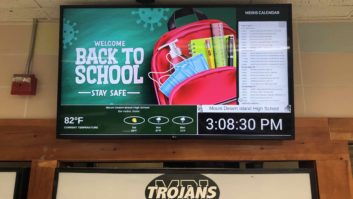 We’ve come a long way from early 2021 when many workers were told to go home and work remotely for ‘a few weeks’ due to the global pandemic. Despite the initial period of adjustment, most of today’s workers have settled into a comfortable remote work routine and found the ability to be productive and focused remained.
We’ve come a long way from early 2021 when many workers were told to go home and work remotely for ‘a few weeks’ due to the global pandemic. Despite the initial period of adjustment, most of today’s workers have settled into a comfortable remote work routine and found the ability to be productive and focused remained.
Much as the transition to fully remote work brought about disruption and uncertainty, many workers are concerned about a similar revamp in their workday as more regions begin reopening offices and hybrid models become the norm.
Business leaders may be surprised at just how much our ways of working have changed during the last year and a half. Likewise, workers may not be ready to completely relinquish the working methods they’ve grown accustomed to, and instead may seek to integrate the best parts of at-home work into at-office work as they move into a hybrid model.
As employees and organisations continue to make their first forays into the hybrid model, the trends outlined here will help set the tone in establishing where, when and how work will take shape.
1: LAPTOPS – THE HEART OF CONNECTION
While the era of the desktop has been on the decline for years, Covid has definitively cemented the era of the laptop as the default model. Employees have relied on and grown more comfortable with their laptops while working remotely, forming a bond unlikely to be broken by a return to the office. In fact, a recent Barco study found that more than three quarters of workers could not imagine working without their laptops anymore.
With the added flexibilities that laptops provide to employees – in particular allowing them to log into and conduct virtual meetings with just a simple click – it is likely that their central role in the world of work will continue. Our ways of interaction in the office are also likely to change when we return. Rather than spending most of our time at a single location, we are more likely to interact with team members in new huddle spaces, making the laptop’s portability an added strength –provided the collaboration tools to share presentations and include remote working colleagues is seamless.
2: VIDEO IS EVERYTHING
How long did we have to wait before seeing our colleagues, clients and customers in person after we started working from home? Too long was often the answer and we spent a large amount of time interacting with other people over video conferencing platforms. Seeing another person’s face was the primary way for us to feel connected with colleagues and customers alike and ensured that video calls became the norm. Given that video became such a key aspect of our lives for so long it’s no surprise that it has become the norm for communicating even as we return to office spaces.
Video conferencing is now a fundamental pillar of working life, and business and IT leaders have a unique opportunity to redesign their office space to make every meeting room a ‘video room’. This includes ensuring that video-ready workspaces offer connectivity for both on-site and remote employees, and that room peripherals – such as microphones, speakers and cameras – are up-to-date and compatible with laptops and mobile devices. Expanded video capabilities also take greater importance as travel restrictions remain in place, with planning meeting and sales demonstrations that previously occurred in an on-site board room now shifting to a virtual arena.
3: VIDEO PLATFORM NAVIGATION
During the remote work period, employees successfully mastered and navigated between multiple unified comms platforms. The average day now potentially includes meetings spread across a number of different platforms, and as hybrid work continues to be the norm, this is unlikely to change. Workers will therefore require the ability to seamlessly move between these platforms at short notice.
It can also be embarrassing if a client or other organisation arranges a meeting on an unfamiliar platform and the technology housed in the meeting room is only compatible with a single UC provider. This situation can be avoided if business leaders look to invest in additional solutions that will connect the user no matter which platform is being used.
These ‘Bring Your Own Meeting’ devices and tools were in use before the pandemic started, but after nearly a year and a half of working from homes, the relevancy of these solutions has only grown.
4: CONTENT SHARING FROM ANYWHERE
Beyond adopting a new-found reliance on video conferencing, employees have enjoyed the convenience of sharing their screens, content and ideas with a simple click of the ‘share screen’ button. In companies with no access to wireless content sharing, employees won’t be keen to return to the frustrations of HDMI cable connectivity in meeting rooms. After months of easy access to multi-person content sharing, collaborating with complex and time-consuming cable struggles are just too much.
The ability to conveniently and clearly share content will therefore become critical for success in hybrid environment. With meeting participants likely mixed among on-site and remote locations, content must remain accessible, visible and actionable for everyone. Fortunately, collaboration technology has evolved to include features that will prevent remote participants from feeling left out, including virtual blackboarding, annotation and the ability to split a larger group into smaller virtual breakout huddles.
5: OFFICES BUILT FOR SOCIAL INTERACTIONS
For many workers, the appeal of returning to the office is the chance to re-engage and collaborate with colleagues. Even with that benefit, the definition of the workplace has changed. It is unlikely that we will view the workplace as a space to just simply put our heads down in silence and get on with our tasks. Rather, the office will be re-imagined in an experience first layout, serving as an area to meet, collaborate and connect with co-workers or customers. With some of the more traditional cubicles and desks making way for more casual seating, our desire to interact on a physical level will drive a more sociable office layout.
Of course, a hybrid structure will mean that some colleagues will be working remotely while others head into the office. This will ultimately mean more internal meetings taking place which in turn poses another issue: where will people be hosting their meetings or internal catchups? There are certainly not enough meeting rooms in typical office spaces to facilitate this, meaning that casual spaces like pods or huddle rooms will need to have some sort of AV equipment installed.
Technology helped us to get through the initial stages of the pandemic, keeping us in close contact with our team and colleagues. However, with hybrid models set to stay for the longer-term, we’ve had to fully embrace the technology we work with and start to form our own positive habits to enhance our working lives.
Now, as we return to the office, business leaders need to be conscious of the fact that employees will want more freedom and flexibility to be able to work in the way that suits them. If businesses do not place the experience of customers and staff at the forefront of their returning plans, they may begin to struggle to attract and retain talent in the new era of working.







